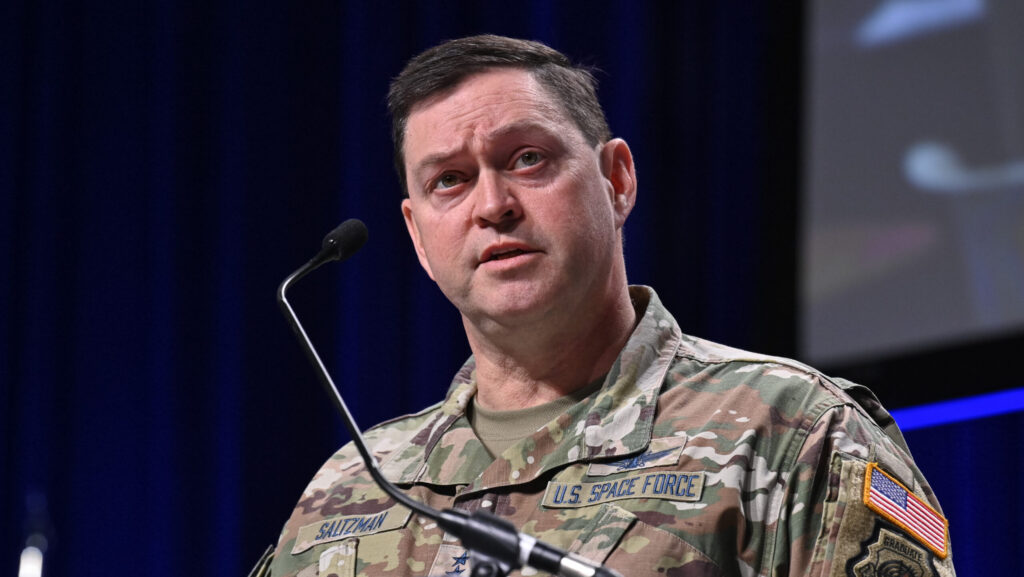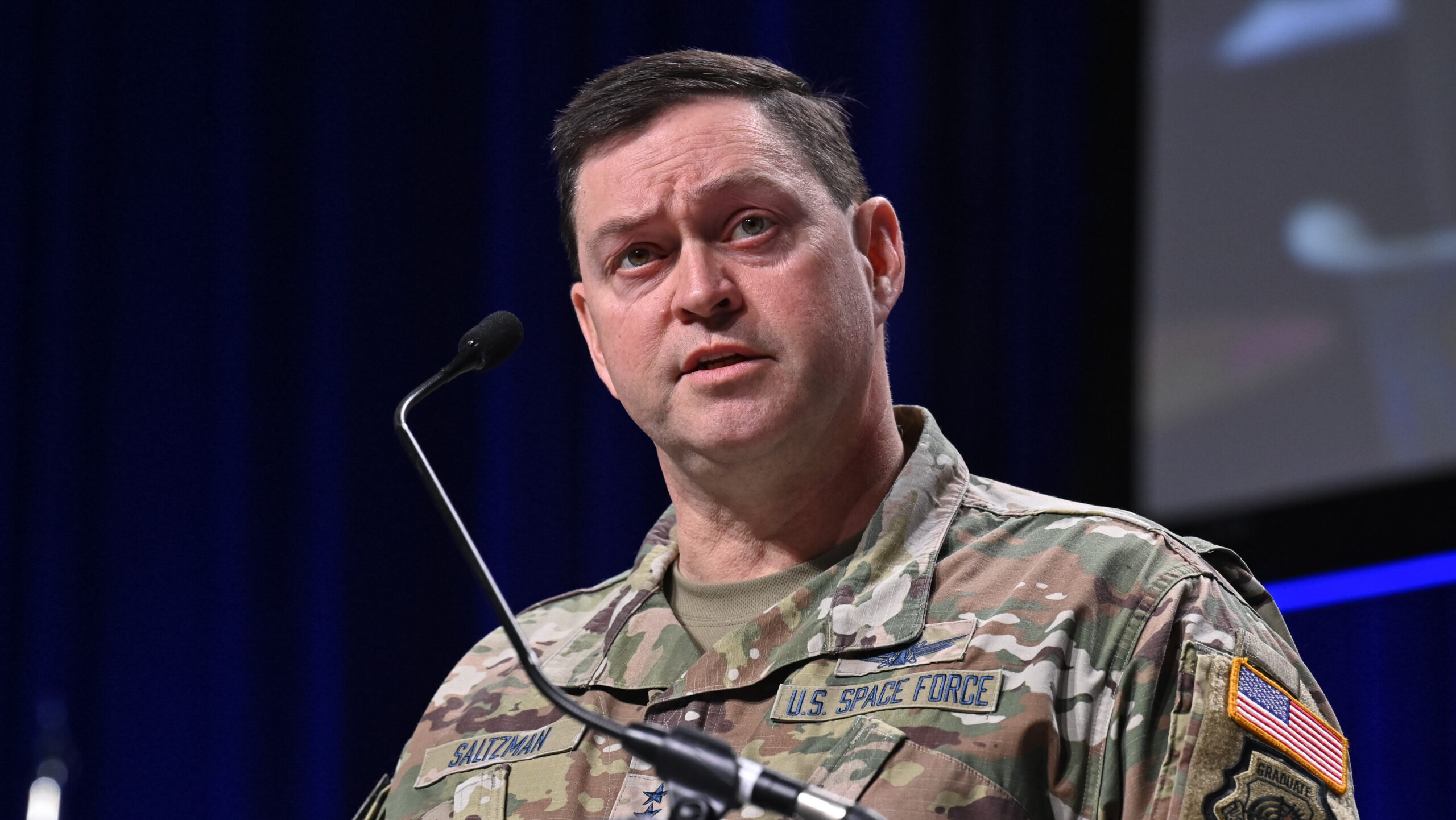
Chief of Space Operations Gen. Chance Saltzman delivers a keynote address on the state of the Space Force during the Air and Space Forces Association 2024 Warfare Symposium in Aurora, Colo., Feb. 13, 2024. (US Air Force photo by Eric Dietrich)
WASHINGTON — The Pentagon urgently needs to clarify the roles and missions of the Space Forceand how it relates to US Space Command, the Intelligence Community and the other military services,according to a new report from the Mitchell Institute.
Only then will the newest military service be able to successfully articulate and advocate for its long-term needs to deter China with the US Congress, the executive branch and the American public, the report concludes.
Those needs, the report stressed, include an explicit mandate and funding to develop and deploy “offensive” weapons, as well as increased resources across the board.
The report — “Ensuring a Spacepower Advantage in Prolonged Competition: Findings and Recommendations from the Space Endurance Workshop” released today [PDF] — was the result of a two-day workshop involving 55 space experts from diverse backgrounds “to examine how the United States, its allies, and partners can maintain an enduring spacepower advantage,” according to institute’s website.
The workshop also focused on a review of the “theory of competitive endurance” put forward by Chief of Space Operations Gen. Chance Saltzman in 2023 to guide Space Force operations against six futuristic scenarios where US space power was challenged, and found it somewhat wanting.
Charles Galbreath, one of the two Mitchell authors along with Jennifer Reeves, explained today that the problem with Saltzman’s theory, identified during the workshop, is its focus on “enduring” — resisting attacks via deterrence and resilience — rather than on “winning.”
“The tenets of competitive endurance — responsible counterspace campaigning, domain awareness, resiliency in the architecture — those are solid lines of effort. It’s kind of the wrapping, though, of competitive endurance, as opposed to a war winning concept, a war fighting strategy, that we think needs to change,” Galbreath said in response to a question from Breaking Defense during Mitchell’s online rollout of the report.
Key findings of the workshop included:
The US Space Force Must Clearly Explain Its Roles and Missions. “Failure to establish and convey these roles and missions could lead to confusion among the services, reduced funding from Congress, and a deterioration of national will to maintain leadership in space,” the report says. Thus, it adds, “the Department of Defense needs to clearly define the roles and missions of the Space Force. Once defined, Space Force must pursue an aggressive and persistent campaign to communicate them.”
Space Must Be Normalized as a Warfighting Domain. “Normalizing space as a warfighting domain necessitates changes to policy, funding, understanding, and operational capabilities,” the report says. “While some fear such developments could drive a destabilizing arms race in space, it is important to recognize that credible deterrence is the only viable path given adversary decisions. Peace through strength needs to become the new mantra for twenty-first century spacepower.”
An Overreliance on Commercial Space May Be Detrimental. “On one side, commercial space greatly expands access to rapid innovation and an increasing set of services available for integration. On the other, an overemphasis on the capabilities commercial entities can ostensibly provide detracts from the critical roles of the Space Force, which is dedicated to national space security in ways private entities are not,” the report explains.
Guardians Must Adopt a Space Warfighting Mindset. “The lack of defined and clearly articulated roles and missions, the lingering view of space as a benign domain, and the encroachment of commercial entities in space security roles have a compounding effect” on the way Guardians perceive themselves and their missions that undercut their ability to advocate the Space Force’s criticality to future warfighting, the report finds.
Improved Space Domain Awareness Is Critical. The report notes that each of the scenarios ran during the workshop “underscored the importance” of space domain awareness, as well as the need to lower classification barriers to sharing space data with allies and partners.
Allied and Partner Cooperation & Integration Are Essential. “Like the discussion on commercial space capabilities, workshop participants asserted that the Space Force needed to take a proactive leadership role in defining what effects and necessary contributions each ally and partner could provide,” the report says. Further, it recommends that the service expand force integration beyond the current 5 Eyes partners (Australia, Canada, New Zealand and the United Kingdom), up the number of Guardians working on partnerships, increase combined force exercises and “enable” more space-related foreign military sales.
Improved Space Warfighting Training Infrastructure is a Critical Enabler. Not only do the Space Force and SPACECOM need improved training capabilities and infrastructure, including “advanced simulators,” for their own use, but also require the ability to allow allies and partners to train in tandem with Guardians.
International Norms Are Key to Responsible Space Behaviors. “By proactively defining which actions in space are acceptable and which will lead to the escalation of tensions, the United States will be positioned to rally international support to counter hostilities,” the report asserts.
Reeves told Mitchell’s online audience today that the institute will follow-up with another workshop in the October timeframe focusing specifically on what conflict in space might look like.
Galbreath elaborated that the workshop will be held at the unclassified level, even though that will “create some some tension for many people.” Doing so, he said, will allow “thorough discussions” about, ‘What does space conflict mean? Where do we draw the line between competition and conflict? … Is there a tripwire for space’?”
The goal, he added, is “expanding the the field of thinking in that area, and looking at how if we ever do go to conflict, can we end it as quickly as possible on terms that are favor favorable to United States and our allies.”










